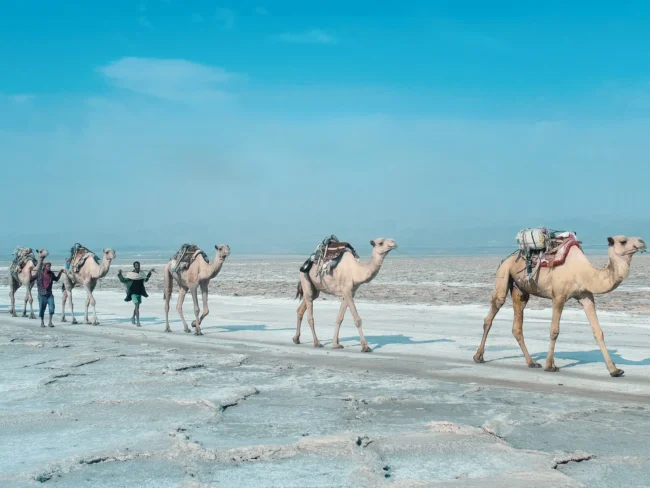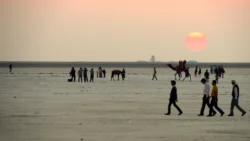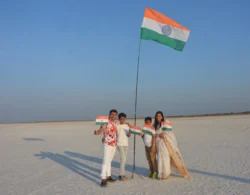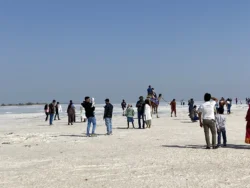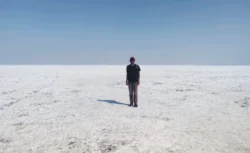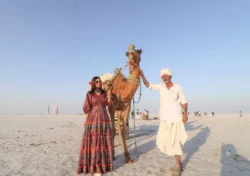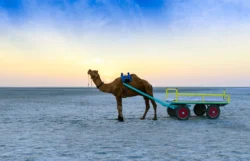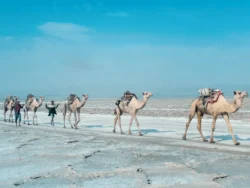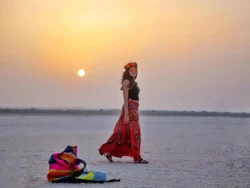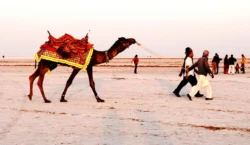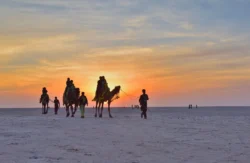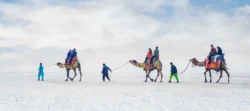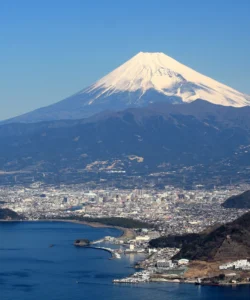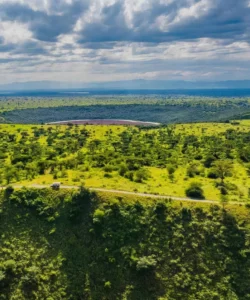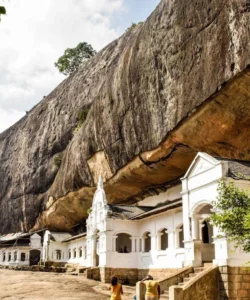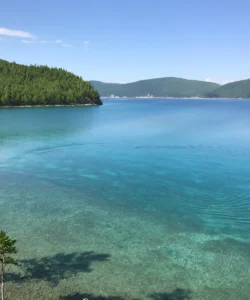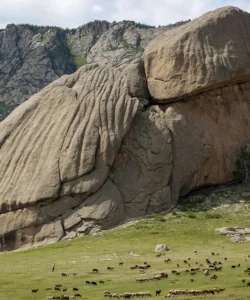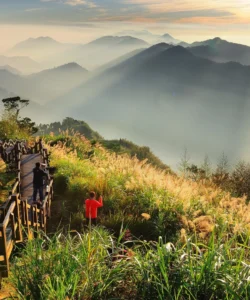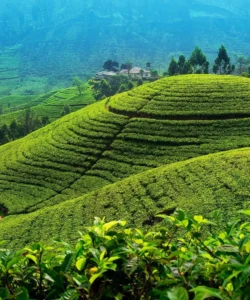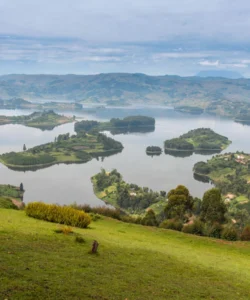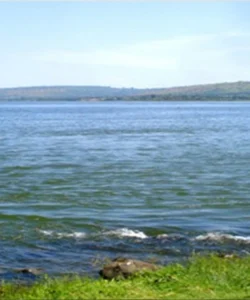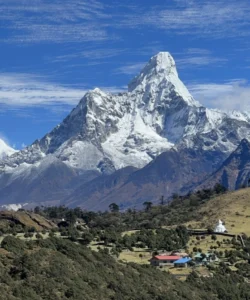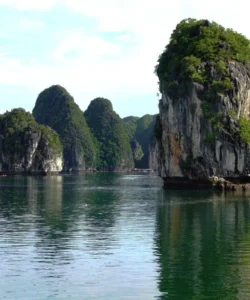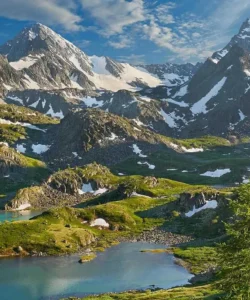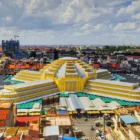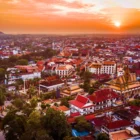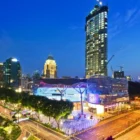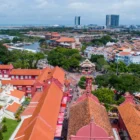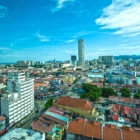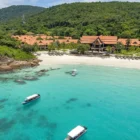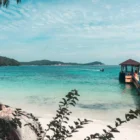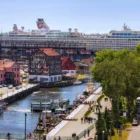The Rann of Kutch is a truly unique natural wonder located in the state of Gujarat, India. It’s an expansive seasonal salt marsh that transforms dramatically with the changing seasons, becoming a vast, shimmering white salt desert for much of the year, particularly famous for its surreal beauty and the vibrant cultural festival it hosts.
Name: Rann of Kutch (Gujarati: કચ્છનું રણ, meaning “Desert of Kutch”). It is divided into the Great Rann of Kutch (the larger northern portion) and the Little Rann of Kutch (to the southeast).
Address: Kutch District, Gujarat, India. The main tourist gateway to the Great Rann is Dhordo village, which is approximately 80 kilometers (50 miles) from Bhuj. The Little Rann is known for its Wild Ass Sanctuary.
How to Get There:
Access to the Rann of Kutch primarily involves reaching Bhuj, the district headquarters, and then taking land transport.
- By Air: The nearest airport is Bhuj Airport (BHJ), which has regular flights from major Indian cities like Mumbai, Delhi, and Ahmedabad. From Bhuj Airport, you’ll need to hire a taxi or pre-arranged transfer to Dhordo (approx. 2-hour drive).
- By Train: Bhuj Railway Station is well-connected to several cities in Gujarat and beyond. From Bhuj railway station, you can hire taxis or take buses to reach the Rann desert area.
- By Road: Kutch has a good network of roads. You can hire a cab or drive from major cities like Ahmedabad (around 400 km / 8 hours) or Udaipur (around 600 km). Buses also operate to the Rann area.
- Organized Tour Packages: Many first-time visitors prefer booking organized tour packages, especially for the Rann Utsav festival. These packages often include transport from Bhuj (airport/railway station) to the “Tent City” in Dhordo, accommodation, meals, and guided sightseeing.
- Permit: Due to its proximity to the India-Pakistan border, certain areas of the Rann (including the White Rann near Dhordo) require a permit for security reasons. These are typically obtained at a check post en route or can be arranged by tour operators/accommodations.
Landscape and Architecture:
The Rann of Kutch’s landscape is truly otherworldly, shaped by geological shifts and seasonal flooding. Its “architecture” is mostly natural, but also includes unique traditional dwellings adapted to the harsh environment.
- Vast Salt Flats: The defining feature is the immense expanse of white salt flats, which form a crust over the marshy land. During the dry season (October to March), this salt crystallizes and shimmers under the sun, creating an ethereal white landscape that stretches as far as the eye can see. It is reputed to be one of the largest salt deserts in the world.
- Seasonal Flooding: Historically, the Rann was once a shallow part of the Arabian Sea, and later a delta of major rivers like the Indus and Saraswati. Today, during the monsoon season (June to September), much of the Rann floods to a depth of about 0.5 meters. The waters evaporate during the long dry season, leaving behind the salt.
- Bets (Elevated Islands): Scattered throughout the flat salt marsh are areas of sandy higher ground, known as “bets” or “medaks.” These small islands rise a few meters above the flood level and provide refuges for wildlife, with sparse vegetation like thorn scrub and some trees.
- Arid Terrain: The region is part of the larger Thar Desert, characterized by an arid climate, extreme temperatures (very hot summers, cold winters), and sparse vegetation, primarily grassland and thorn scrub.
- Traditional Bhunga Houses: The traditional dwellings of the local Kutchi people are Bhungas. These are unique examples of mud architecture: circular huts with conical thatched roofs. They are highly resilient to earthquakes (a common occurrence in the region, particularly after the devastating 2001 Bhuj earthquake) and provide natural insulation against the harsh climate. Bhungas are often adorned with intricate mud-mirror work and vibrant decorations, reflecting the rich artistic traditions of Kutch.
- Tent City Dhordo: During the Rann Utsav festival, a temporary “Tent City” is constructed in Dhordo village, featuring well-appointed tents and “bhunga” style cottages, designed to offer a blend of luxury and traditional Kutchi aesthetics.
- Kalo Dungar (Black Hill): The highest point in Kutch, offering panoramic views of the Great Rann stretching to the horizon. It has a Dattatreya temple and is known for its tradition of feeding jackals.
What Makes It Famous:
- Largest Salt Desert in the World: The vast, shimmering white salt flats of the Great Rann of Kutch are its most defining and famous feature, creating a surreal and unique landscape.
- Rann Utsav Festival: The annual, three-month-long Rann Utsav (Desert Festival), held from approximately November to February, is a major cultural highlight. This vibrant festival showcases the rich Kutchi culture, folk music and dance, handicrafts, traditional cuisine, and adventure activities (camel safaris, ATV rides, paramotoring), all against the stunning backdrop of the white desert.
- Spectacular Sunrises and Sunsets: The endless flat expanse of the white desert creates an unparalleled canvas for breathtaking sunrises and sunsets, with the sky painting the horizon in a kaleidoscope of colors.
- Unique Ecosystem and Wildlife: Despite the harsh conditions, the Rann is home to unique wildlife adapted to the salt marsh and desert environment. The Little Rann of Kutch is home to the Indian Wild Ass Sanctuary, the last refuge of the endangered Indian wild ass (khur). It’s also a significant breeding ground for flamingos (Flamingo City) and other migratory birds, making it a birdwatcher’s paradise.
- Rich Kutchi Culture and Handicrafts: The region is renowned for its diverse communities (Rabaris, Ahirs, Mutwas, etc.) and their vibrant culture, particularly their exquisite handicrafts like intricate embroidery (including mirror work), Rogan art (a unique fabric painting), lacquer woodwork, copper bells, and leather crafts.
- “Chir Batti” (Ghost Lights): A mysterious, unexplained dancing light phenomenon, locally known as “Chir Batti” or “ghost lights,” is reported to occur at night in the Rann and nearby grasslands, adding to its enigmatic allure.
Differences from Some Other Wonders:
- Salt Desert Landscape: Unlike conventional deserts (like the Thar Desert with its sand dunes, or the volcanic landscapes of Bromo/Ijen) or vast water bodies (Lake Toba, Kerala Backwaters), the Rann of Kutch is defined by its unique and extensive salt flats, which are submerged seasonally, making it a “seasonal salt marsh” rather than a dry sand desert or a permanent lake.
- Seasonal Transformation and Festival: Its dramatic transformation from a flooded wetland to a dry, white salt desert, combined with the major Rann Utsav festival that actively uses this seasonal landscape as its venue, is a key differentiator. Many wonders are static or have fixed annual events, but the Rann’s very identity shifts with the seasons.
- Cultural Experience Integrated with Natural Phenomenon: While many natural wonders have local cultures, the Rann’s fame is heavily driven by the vibrant Kutchi culture and handicrafts that flourish within and around this stark natural environment, particularly highlighted during the Rann Utsav, making it an integrated cultural-natural spectacle.
- Absence of Monumental Architecture (within the Rann itself): Unlike ancient temples (Angkor Wat, Borobudur) or grand palaces (Mysuru Palace, Red Fort), the core “wonder” of the Rann is its natural landscape. The “architecture” you encounter is primarily traditional, adaptive Bhunga houses or the temporary Tent City, rather than historical monumental structures.
- Specific Wildlife (Wild Ass, Flamingos): While it has wildlife, its focus is on specific adaptations to the salt desert, like the endangered Indian Wild Ass and flamingos, rather than a broad “Big Five” safari or rainforest biodiversity.
- Border Proximity: Its location directly bordering Pakistan adds a geopolitical dimension and specific security regulations, which is not typically a feature of other natural wonders.
Rann of Kutch Photos:
